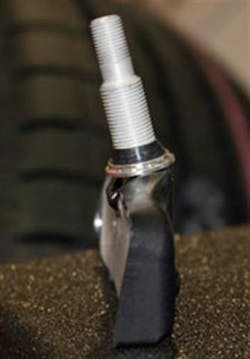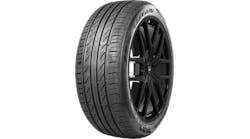TPMS standardization, sensor proliferation direct vs. indirect, RFID and a possible repeal of TPMS?: Intelligent Tire Technology Conference covered it all!
The look on the woman's face said it all. "Intelligent tire technology," she mumbled to herself. "What will they think of next?" Throughout the day, most people who saw the big sign in the lobby of the hotel probably thought the same thing.
But I have a definite interest in intelligent tire technology. That's why I had traveled to Livonia, Mich., for the first-ever Intelligent Tire Technology Conference.
'It depends'
When the conference organizers contacted me about giving a presentation earlier this year, I was honestly more excited about learning from the other presentations.
A few months later, I received the promotional material and was shocked to see that I had the honor of providing the keynote address to kick off the conference.
I guessed that nobody in attendance had ever considered the subject from the perspective of an independent tire dealer, so I decided to take advantage of the opportunity.
My presentation centered on how tire pressure monitoring systems are affecting the aftermarket.
[PAGEBREAK]
I've traveled thousands of miles and talked to thousands of tire dealers in an effort to prepare them for the inevitable changes that will accompany this technology.
I wanted to make sure that vehicle, sensor, and chip manufacturers heard dealers' voices.
I started with some quick facts about the North American passenger and light truck tire replacement market. Believe it or not, some of them had no idea that more than 230 million replacement consumer tires were sold on an annual basis.
There was also some level of amazement when I started providing the demographics for the estimated 26,000 independent tire dealers. Once again, many of them had no idea that the majority of the independent tire dealers were single store owners with less than $1 million in annual sales.
Seeing that I had their attention, I turned to the lack of available tire pressure monitoring system (TPMS) training.
Conspicuously absent from the list were most of the manufacturers in the room, which also came as a shock to some in attendance. "How can we put this radically new technology on the market with practically zero technical or training support?" they asked themselves.
I refrained from the sarcastic response I wanted to give and instead spent most of the remaining presentation talking about the state of TPMS in the aftermarket.
At this point in time, the answer to every question related to TPMS is, "it depends." Will this scan tool work on every type of vehicle? It depends on what you're trying to do. Do you have to reprogram the TPMS after a rotation? It depends on what type of vehicle you're working on. Do I need a factory scan tool? It depends on what type of sensor you're trying to replace.
Are the seal kits readily available? It depends on how far you are geographically located from the new car dealer for the brand you need. Will the customer's car have to go back to the new car dealer after servicing the tires or TPMS? It depends.
[PAGEBREAK]
More info needed
With the full realization that nothing is standardized or consistent between manufacturing platforms, the attendees were ready to get a wish list from the aftermarket for the next generation of TPMS.
I started with the reliance on OEM scanners and software when sensors were in need of replacement. As it stands right now, a TPMS sensor is basically the only component on the vehicle that cannot be easily replaced in the aftermarket.
I took a few shots at the sensor and seal kit manufacturers and asked for the number of necessary part numbers to stop before we reach 100. Finally, I practically begged for whatever useful service information they could provide.
My presentation was well-received. Quite a few people thanked me for providing such a comprehensive and honest summary of how TPMS was affecting the aftermarket. Most of them were engineers and judging from some of their comments, a few of them don't get out much.
I'm not sure if anyone had the necessary authority to actually change things for the better, but I didn't care. Like most things in life, it ultimately comes down to the decision of one person and if someone in the crowd was that person, knew that person, or worked for that person, I figured I would make an effort to try and make things easier for independent tire dealers.
[PAGEBREAK]
The OEM's dilemma
Day two started with a very informative and entertaining presentation from John Maxgay, lead engineer with General Motors Corp. John is the lead engineer for TPMS at GM and appreciates what the aftermarket is faced with simply because he has to explain to his bosses why the customer didn't give GM a favorable TPMS rating on the all-important JD Power & Associates survey after they purchased their new vehicle.
He told a story of how a Cadillac customer wanted to purchase a new car for his wife on Christmas with the big red bow and everything. The dealer took the car inside and detailed every inch until it was ready to go. On Christmas Eve, the customer took the car out of the nice warm dealership and parked it in the driveway where the temperature was about 50 degrees colder. Of course, his wife was thrilled, but when she started her new car and saw the yellow low tire pressure light (which looks like a horseshoe with an exclamation point in the middle) on her dash, she told her husband the car had to go back to the dealership.
Needless to say, a man who can buy a Cadillac for his wife at Christmas is someone they want to keep happy! The next business day, they took the car back and parked it in the nice warm garage so they could find the problem. You guessed it: no light. This went on for a day or two until they finally figured it out. It's nice to know that tire dealers don't have all the fun.
To make matters worse for John, when something goes wrong with the TPMS following a tire replacement or rotation and the customer returns the vehicle to the dealer, GM also takes the warranty hit.
He explained how most people just don't know what the yellow horseshoe light with the exclamation point in the middle means, so GM is going to make additional efforts to educate the consumer on the importance of TPMS.
The first message that obviously needs to be received is that if the yellow horseshoe light with the exclamation point is illuminated on the dash, the driver should check the inflation pressure in the tires.
[PAGEBREAK]
RFID and TPMS
Bob Benedict, senior research and development associate for the Goodyear Tire & Rubber Co., followed with a very interesting presentation on how NASCAR is using radio frequency identification technology in tires.
They are building the sensor into the tire during the manufacturing process so there's no external device to monitor the inflation pressure.
I learned that this is not an easy process because the electronics can be easily damaged while the raw rubber cures and naturally flows during the vulcanization process.
The conference chairman was a man named Mark Shaw, senior systems engineer for a semi-conductor manufacturing company called Freescale. His presentation was definitely the one that I remember most.
For the first half of his presentation, I felt like I was standing on the end of the runway. There's no way I can possibly explain what Mark covered because it was an in-depth discussion on the engineering that takes place inside a sensor. It's a highly complex combination of things like diode stacks, resistors, microcontrollers, oscillators and in most instances, a lithium battery.
By the time I saw the slide entitled "TPMS Field Issues," it was already obvious to me that Mark was an expert on semiconductors and TPMS sensors, so I was very interested in what he viewed as the problems faced by the readers of Modern Tire Dealer. His first point centered on the vast array of TPMS architectures and features. Among the effects he noted was the stress that will be placed on the OEM dealer and spare parts networks.
He also explained that the tire/wheel replacement infrastructure would suffer and consumers can expect difficulty in having rapid access to replacements. If any of the following solutions that he proposed ever come true, every tire dealer in North America should send him a card at Christmas:
* Standardized data interfaces for interoperability.
* Field programmable TPMS wheel module.
* Migration to battery-less solutions built into the wheel.
If the vehicle and sensor manufacturers can collectively agree to include the same basic programming requirements, there could be a day when sensors are interchangeable, he said. This can also be accomplished at the receiver level because it can be designed to accept multiple protocols and additional data bytes.
There are already some common characteristics of all sensors, so it's possible that the interoperability that Mark suggests could be achieved.
On the subject of field programmability, I believe his roadblock of sharing the programming and the resulting royalty distribution is the sole reason it's not already in place.
[PAGEBREAK]
TPMS repeal?
Mark finished by discussing the issues surrounding TPMS replacement and started with the fact that the sensor may come at a higher cost than the tire!
When combined with the inevitable delays in availability and the dependence on the OEM dealer supply chain, he projects that customer dissatisfaction will begin to rise within the next four to six years. I personally think it's already on the rise and could become a political hot potato by then.
According to Mark's estimates, the average lifespan of a sensor is 5.7 years, so consumers could expect at least two sets of sensors over the life of a vehicle.
That translates into a market where 10 million sensors in 2006 grows to 25 million in 2007, 45 million in 2009, 55 million in 2011, and by 2023, the annual sensor replacement market will reach approximately 85 million.
And about 10 years from now, demand for replacement sensors will be greater than the demand for OE sensors and by 2023, the replacement market will be twice as large as the OE market.
But then Mark informed the audience that they -- the sensor and chip manufacturers -- have the ability to make it easier for both consumers and the replacement market and if they don't, the legislation that led to TPMS will be reviewed.
If the government gets enough pressure from voters because the systems are impossible to maintain and ridiculously expensive, the TPMS requirement could be repealed.
[PAGEBREAK]
Direct: still the best
The final session I attended was a panel discussion with the title, "Direct vs. Indirect TPMS."
I haven't held back on my opinions regarding indirect TPMS and after Mark (who served as moderator) and I had a nice conversation on that and other subjects the previous day, he asked me to explain my position.
I pointed out the fact that vehicles with indirect TPMS must be driven in order to recalibrate the system which puts tire dealers in a difficult position because the responsibility isn't as clear as it is with direct TPMS.
Plaintiff's attorneys are going to suggest that the dealer is responsible, and that's all it takes to wind up in court.
Throughout the conference, the recurring theme was the overwhelming need for consumer and technician education. Consumers have to be educated on what to do when the light comes on and why TPMS is an important safety system that they want to maintain.
Consumers also need to feel that the investment in replacement sensors is more than just required by law.
And with all of the differences in servicing and replacing sensors, technicians are also in dire need of training and education.
A few months ago, I suggested that tire dealers need to become TPMS experts in order to survive. After participating in the Intelligent Tire Technology Conference, I'm convinced the industry doesn't have a choice.
[PAGEBREAK]
Same issues, different solutions: Conference explored various TPMS-related technologies
The recent Intelligent Tire Technology Conference in Livonia, Mich., also included a number of presentations from companies in the tire pressure monitoring system field. Here's a first-hand report from Kevin Rohlwing, MTD correspondent and senior vice president of education and technical services for the Tire Industry Association:
* "A good friend of mine, Al Cohn, director, new market development and engineering support for Pressure Systems International Inc. (PSI), followed me (around the conference) and did his usual expert job of explaining how central tire inflation systems work on large commercial trailers. He pointed out that identifying the tire in need of air is important, but that won't save the tire or casing. The PSI system accomplishes both goals by notifying the driver that one or more of the trailer tires is losing inflation pressure. The driver can usually make it to the next truck stop because air is constantly being added to the tire using the air system already in place for the brakes."
* "The next presentation was of a product that I've seen before where a large, powered valve cap serves as the sensor. While there isn't anything to really break or replace, the questions of theft did come up. The presenter assured us that the lock mechanism under the cap would prevent such losses. Regardless, I thought it had some definite commercial applications. However, the likelihood of the average consumer wanting a huge black valve cap on his rims has to be small."
* "Everyone's life is touched in some way by satellite technology. Tirestamp is a company that uses anyone's TPMS sensor to track tire inflation pressure from anywhere in the world. Using this technology, the driver can be notified that a tire is going flat while the dispatcher is finding the next service location. It also appeared to have a lot of possibility in tire testing and evaluation."
This article is part of a regular series written exclusively for Modern Tire Dealer>i> by Kevin Rohlwing, senior vice president of education and technical services for the Tire Industry Association.




